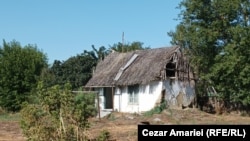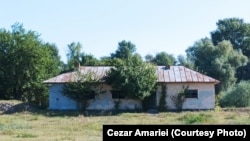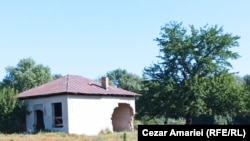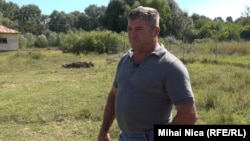PLAURU, Romania -- Little moves through the dusty streets of this hamlet in eastern Romania except that which is blown by the wind.
Situated across the Danube River from the Ukrainian port city of Izmayil, Plauru is home to just 21 residents and a string of crumbling, abandoned houses that once made up the largest commune on this stretch of the Danube Delta, some 300 kilometers east of Bucharest.
The village no longer has a school, a medical clinic, or a store. For those, villagers must walk 6 kilometers, regardless of weather, to the next largest settlement, Ceatalchioi. The church and the cemetery remain.
Plauru -- known as Lascar Catargiu until 1962 -- might have died out quietly if not for Russia's full-scale invasion of Ukraine that President Vladimir Putin launched in February 2022.
Now, the Romanian Defense Ministry has installed air-raid shelters in Plauru after repeated Russian attacks on Ukrainian sites across the river and multiple discoveries this month of drone fragments on the Romanian side.
The government in Romania, a NATO member, is so far not planning to evacuate Plauru and the surrounding communities. And some residents say they don't want to go.
"I want to stay. It's beautiful here, I like it," Marius Tanase, 21, told RFE/RL's Romanian Service.
Tanase's parents have a 9,000-square-meter plot, a few hectares of agricultural land, and livestock at their micro farm, including 12 cows. He is an exception in Plauru: a young person who hasn't already left.
The only three minors in the village are the three children of 52-year-old Cornel Nita, who are aged 11, 14, and 16.
Nita's two younger children go to school in Ceatalchioi, while the eldest attends high school in Tulcea, which is 30 kilometers away.
Nita, a former sailor, says he doesn't want his children to stay in Plauru.
"Let them go about their business -- farther," he says, shrugging his broad shoulders. "What is there to do here?"
'A Lot Of People Left Here'
Located just 300 meters from Izmayil, Plauru is the closest Romanian town to the war zone ignited by Russia's invasion.
The hamlet had over 400 inhabitants in 1930 and was the largest settlement on the Chilia branch of the Danube. But flooding in 1970 depopulated the area.
"A lot of people left here, from this village. Until then it was big, it had three rows of houses," local resident Costel Tanase, 52, told RFE/RL's Romanian Service.
Nita grew up in the village. For him the village is filled with memories that will be erased when he's gone.
He points to the remains of a house previously used by border guards. A tree now juts out through the one of the broken windows of the one-story building.
The house only still stands because it is used as a polling station. The school next door was not so lucky; its facade is marked by a massive hole.
"They built it 50 years ago and never got around to using it. There were gardens, volleyball courts, etc., here. But over time, they disappeared," Nita says.
'We'll Have To Leave Here'
The locals in Plauru have an up-close window into Russia's war of aggression in Ukraine.
"When the air-defense system fires, the [missiles] fly from there. We also hear the drones approaching. When they fall, it's a natural disaster, shaking like an earthquake," local farmer Gheorghe Puflea says.
Last week, the Romanian government put counties in the area on alert after the detection of "groups of drones heading toward Ukrainian ports." Area residents received alerts telling them to seek shelter due to the "possibility of some objects falling from the airspace."
"If it gets worse and drone strikes become more frequent, especially if one falls on a house in the village, then we won't be able to do anything. We'll have to leave here," Costel Tanase said.
Romanian Prime Minister Marcel Ciolacu has publicly tried to calm nerves, saying the NATO member was not being targeted by Russia.
"No one attacked us, and no one is attacking us," Ciolacu said on September 13.
"Some remains jumped from a drone that was hit by the Ukrainian Army. It didn't have explosives. It didn't have anything that could harm citizens," he added.
Regardless of the proximity to Russia's war on Ukraine, Nita, the former sailor, says he's unlikely to stay in Plauru.
"I think I will leave again by ship, because I don't belong here," he said.














